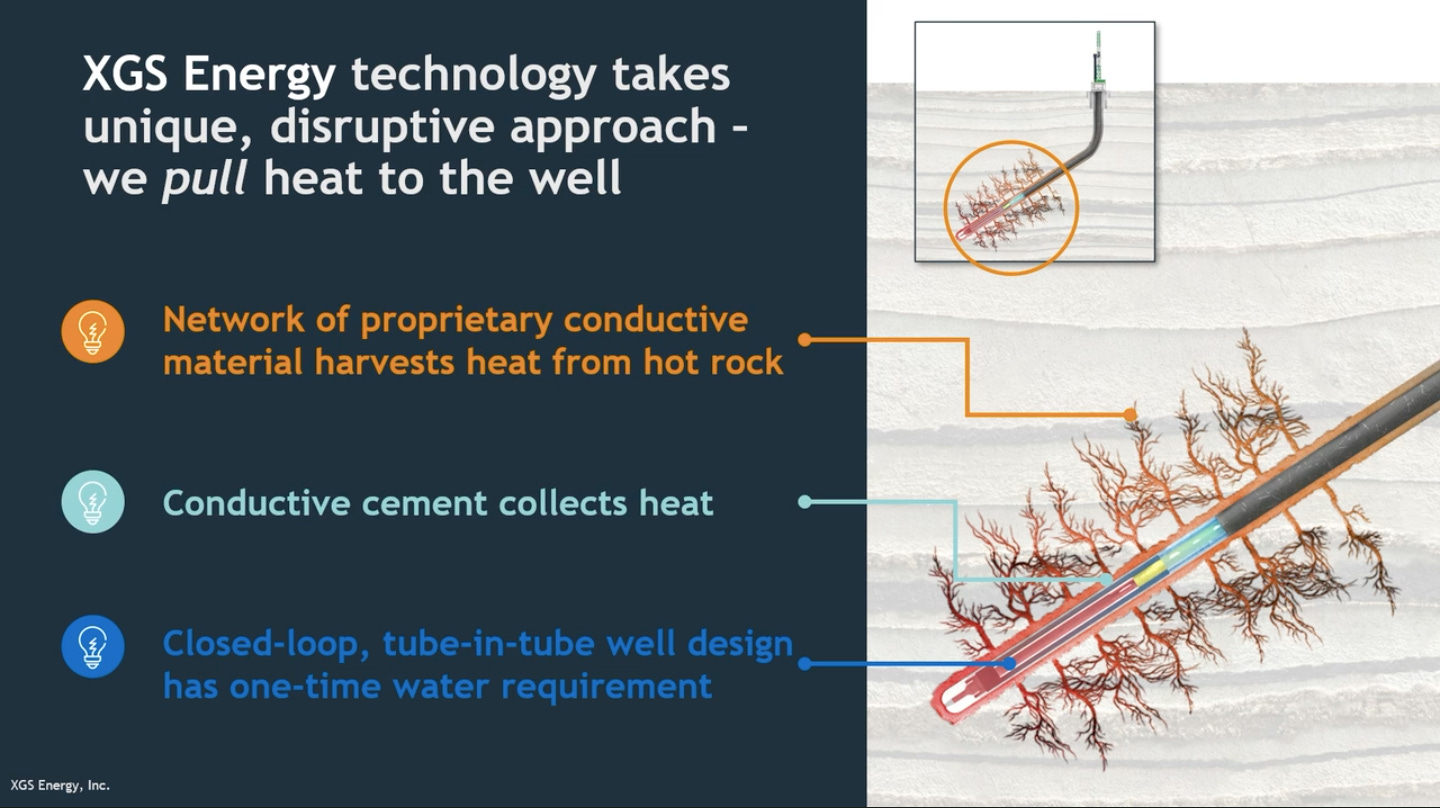The wonderfully wild world of energy ideas
Clean, affordable energy will be one of the defining topics of our future.
There is no low-energy, high-income society. Billions of people still need basic access to reliable electricity and the gaps in electricity consumption are huge.
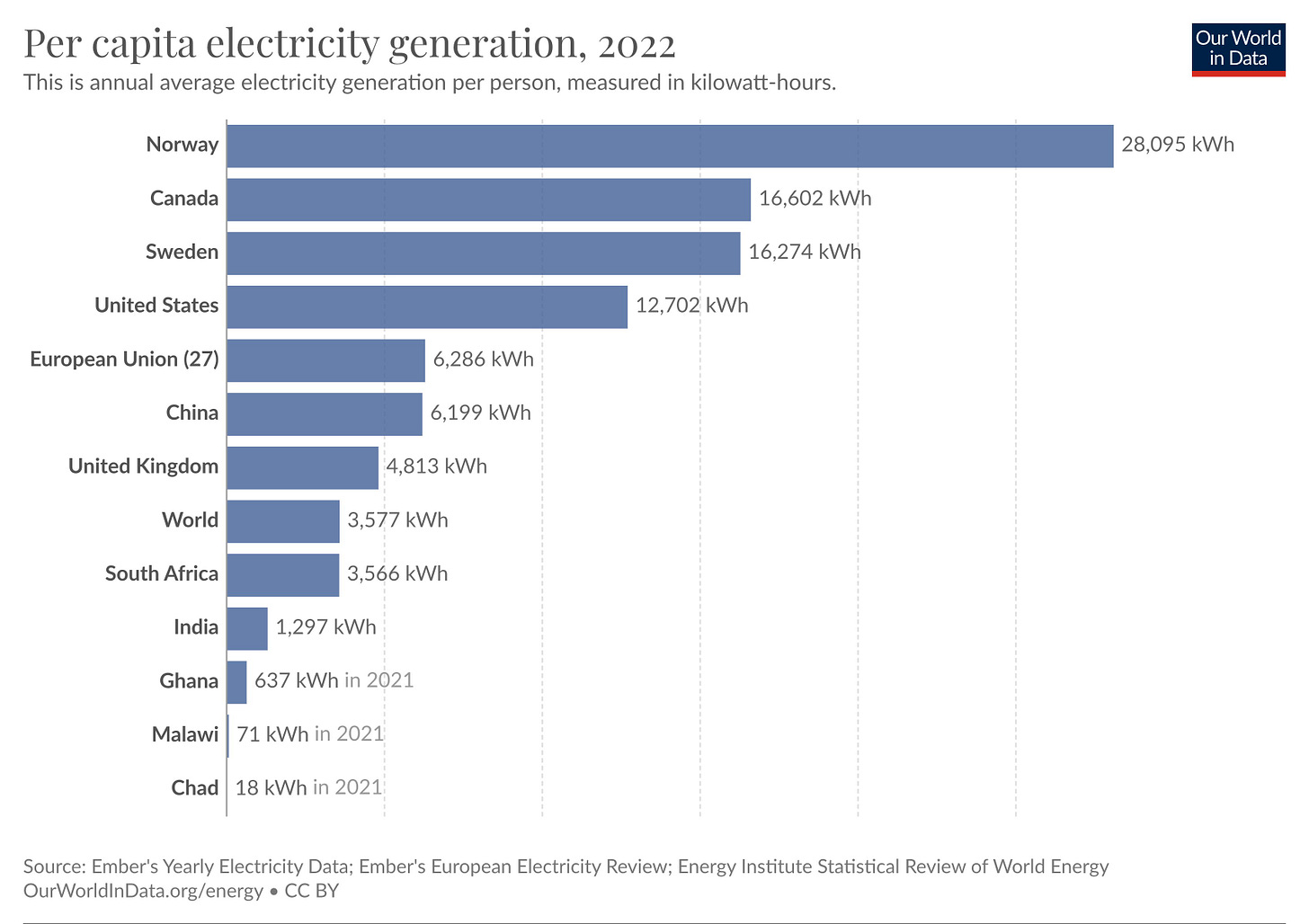
A lot of people are working on finding a source of energy fitting the bill.
Given the magnitude of the challange and the possible profits, it’s not too surprising that people get creative. Here are some of the less common ideas I have come across in the last month:
Electricity from methane - without CO2
The Allam-Fetvedt-Cycle technology is becoming more mature. This technology uses a supercritical CO2 turbine and pure oxigen to burn methane.
This CO2 leaving the process is at high purity and high pressure - fit for geological deposition.
There has recently been an interview with the CEO of the company, Danny Rice and Robert Bryce , which you can find here.
In it, a possible price of $20/tCO2 has been mentioned. Low-cost, super-low CO2 emission reliable power might be within reach for countries with access to natural gas.
Geothermal
Fervo Energy is advancing enhanced geothermal power technology by using the “classical” horizontal drilling and fracking technologies developed by the oil&gas industry to produce viable geothermal reservoirs.
They recently reported reaching a milestone that many observers were expecting to see only in several years.
Their idea is to drill multiple, horizontal holes, fracture the rock between these channels and circulate hot water through these cracks to mine for the heat of the rocks.
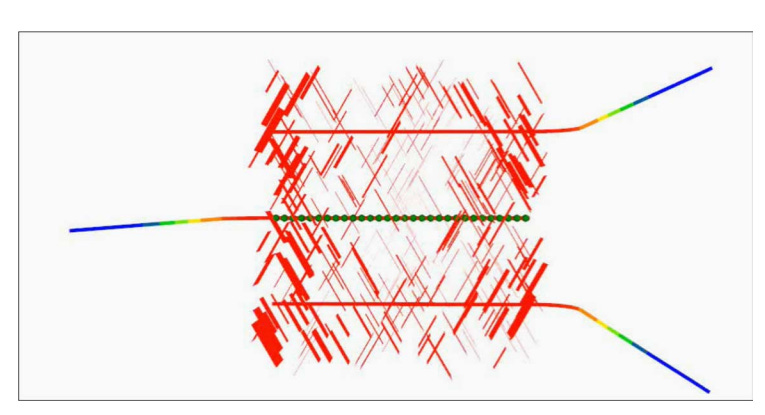
XGSEnergy is developing a different geothermal system, where a tube-in-tube design recirculates water in a closed loop system through one hole.
To increase the contact area, they frack the surrounding material and force a heat conductive material (possibly aluminum pellets) into the cracks to create a conduit for heat. After the stimulation of the well, the bore hole is encased with cement. This is supposed to help connect the heat conduits to the circulated fluid. While Fervo has to deal with the risk that fractures are not connecting the bore holes, XGSEnergy’s design does not.
Their goal is to reach 300C+ temperatures where conventional steam turbines become practical. Future cost reduction might come from faster drilling, longer and hotter laterals, and increased pipe diameter for higher flow rates.
Eavor is another geothermal company looking to build closed-loop geothermal systems. They try to engineer a “radiator” formed by horizontal bore holes filled with a low pressure fluid circulating in it.
Their concept could work almost everywhere, except for deep sedimentary basins. Their concept is robust with respect to fracking bans, seismic activity, and poor fracture connectivity. There is a high probability of having acceptable geology below any customers’ feet for process heat applications.
The thermal output of an Eavor system is more predicatble than for the competing approaches, that rely on some amount of “random” fractures to work: a lack of connectivity or short-circuiting between wells might render those lost assets. This comes at the price of having to engineer and “carve” the radiator from the rock several kilometers deep underground.
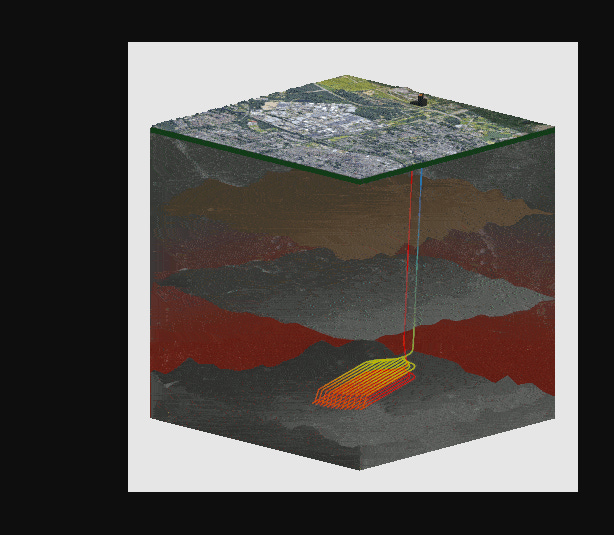
Next to improvements in the design of the geothermal systems and wells, companies are also making progress with respect to the drilling technologies that are used. Polycrystalline Diamond Compact (PDC) bits can be used for faster drilling than traditional roller-cone bits. They already demonstrated speeds of up to 60'/hr in granite. Because there are no moving parts or seals on PDCs, they can tolerate high temperature drilling better and are therefore better suited for the depth that geothermal power needs to work effectively.
Some companies are working towards “contactless” drilling. Quaise is trying to use microwaves to bore through rock to depths of up to 20km. At these depths, temperatures are high enough to think about supercritical water, which raises the efficiency of the electricity generation tremendously. Even repowering existing coal power plants might be feasible, because the temperature levels at these depth are compatible to current steam systems of coal power plants.
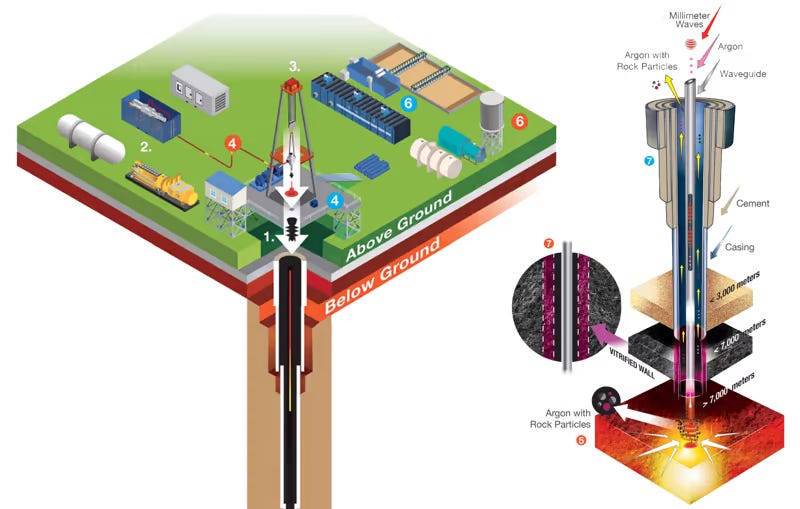
GA Geothermal is working on plasma drilling technologies towards essentially the same goal as Quaise. Apparently, they are aiming for “only” 10km deep holes.
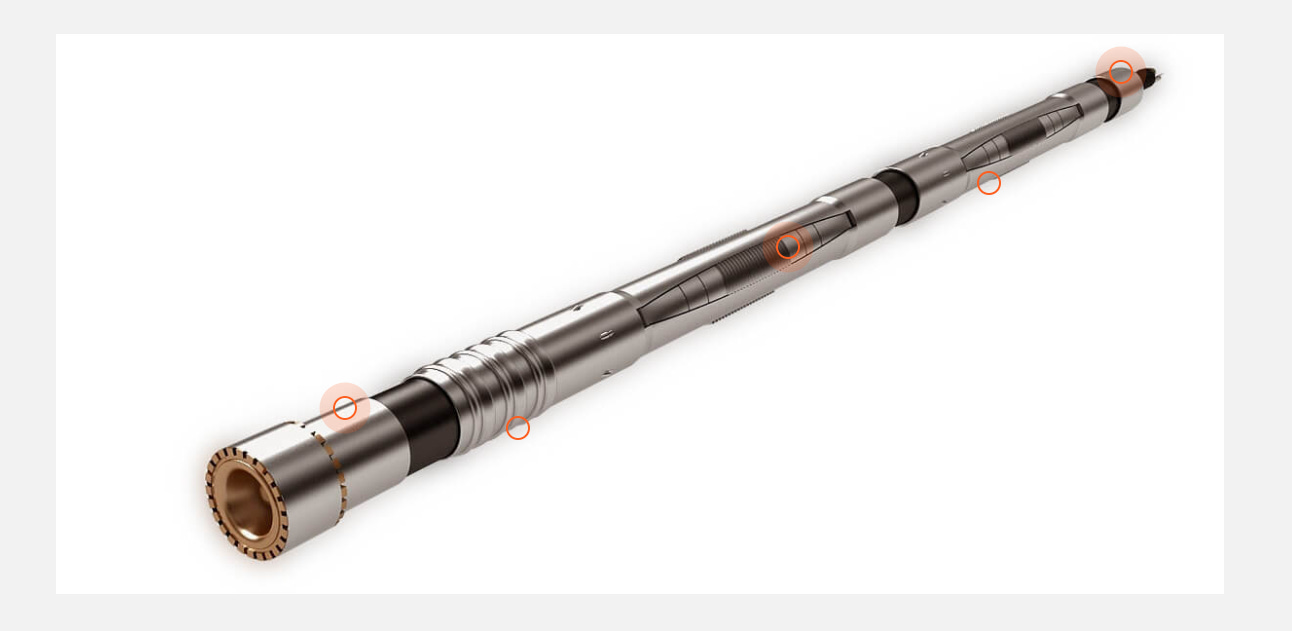
Given how much “learning by doing” is still necessary, geothermal is in a race to break out from being niche energy technology forever. Falling costs for other forms of renewable power and storage (especially thermal storage), are reducing the opportunities for geothermal power as a source for clean heat and electricity. Austin Vernon has a fantastic post on geothermal’s chances.
Hydrogen from methane - without CO2:
The same company that developed the Allam-Fetvedt-Cycle, 8Rivers, is also working on a process to create hydrogen from methane, while capturing the CO2. It uses pure oxygen for the splitting of the methane and captures all CO2 that is produced.
An alternative approach is methane pyrolysis, where some form of carbon-free high-temperature heat, possibly from GenIV nuclear fission plants, is used to split the carbon-hydrogen bonds in methane. This process produces solid carbon and hydrogen.
Photovoltaic cells powered by chemical fuel
Lightcell is working on an engine that burns fuel or hydrogen mixed with sodium. The idea is that hot sodium emits light with a really narrow spectrum.
You can build photovoltaic cells that are tuned exactly to the emitted photons (2.1 eV). The developers are targeting >40% wire-to-wire efficiency when used with hydrogen produced by electrolysis. If it works cheaply enough, these fuel-powered PV cells could be an alternative to batteries.
Photovoltaic cells powered by nuclear fuel
In a Titans of Nuclear episode the company Solid Atomic introduced their idea of small, seabed-based nuclear reactors working with photon-intermediate direct energy conversion (PIDEC).
Just like with the Lightcell setup, the reactor would feature special photovoltaic cells, that are tuned to a the light emitted by a fluorescent, gaseous materials, which get stimulated by neutron emissions of the the nuclear fuel undergoing fission. Such a reactor would be cooled by the surrounding seawater and have no moving parts, except for the shutdown rod. Such a system could reach in access of 60% conversion efficiency.
Electricity storage with cement and coal
Researchers at MIT have created a supercapacitor from cement, carbon black and water. Such a supercapacitor could be incorporated into the foundation of a house, where it would be able to store a day’s worth of electricity while adding little, if any cost to the foundation. Even more speculative uses are envisioned for roads made of this mixture, maybe even with the capacity for charging EVs traveling on it.
Hydrogen from the ground
Hydrogen is often talked about as a potential energy of the future.
Typically, people are talking about zero-carbon hydrogen derived from different source, for example by electrolysis of water using solar, wind or nuclear power, hydrogen derived by pyrolysis from methane or hydrogen derived from methane with carbon-capture.
But there is another source of hydrogen, straight from the ground!
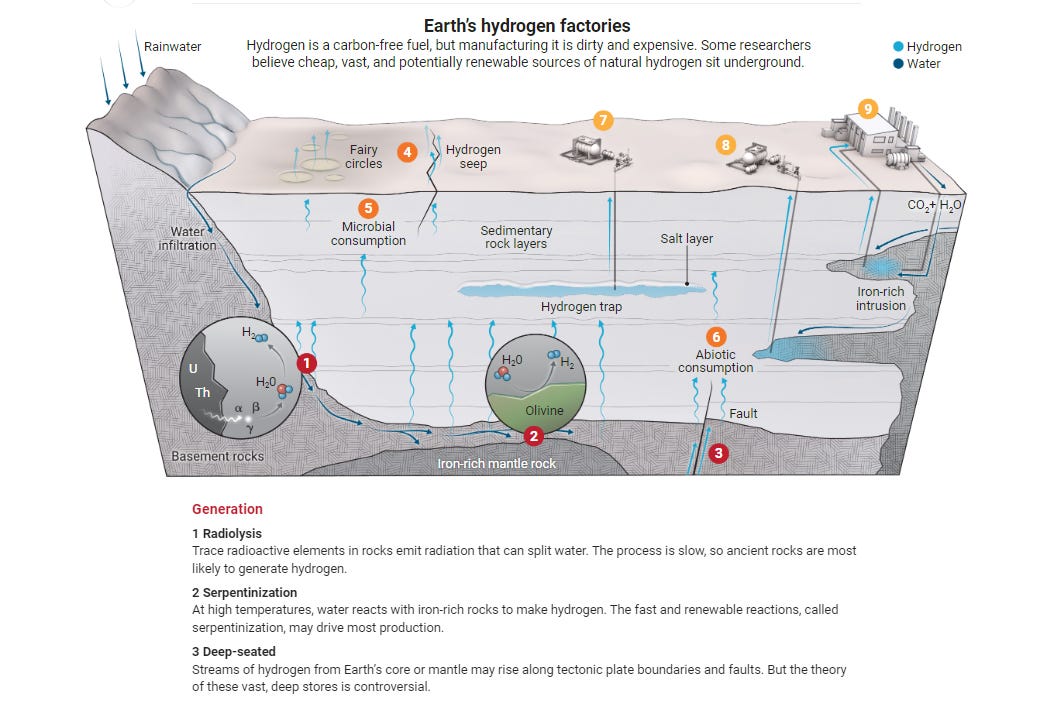
The first scientific discussion of natural hydrogen dates to at least 1888 when hydrogen was seeping from cracks in a coal mine in Ukraine.
Reports of hydrogen are relatively common throughout the former Soviet Union—because Soviet researchers were looking for it. They held to a theory that would have required significant amounts of natural hydrogen to produce oil from nonliving processes rather than from ancient life. (See for example here)
Hundreds of hydrogen seeps have now been documented around the world.
The first target for natural hydrogen explorers will probably be shallow accumulations that sit under caps at a depth of 1-2km.
If the source rocks themselves are within reach hydrogen might be collected by direct stimulation, akin to fracking for shale by injecting water into the iron-rich rock. If carbon dioxide were dissolved in the injected water, it is spaculated that it could react with magnesium and calcium in the iron-containing rocks and be locked up permanently as limestone, while hydrogen is being produced.
Natural hydrogen is far from being a mature economy and scientists don’t completely understand how it forms or whether it accumulates in a commercially accessible reservoirs.
Space-based solar
Solar power has become increasingly cheaper to the point where “value deflation”, land-usage and reliability issues of grids become more pronounced.
The idea of putting solar panels into space, where they are neither subject to day and night cycles, nor land-usage issues, have been discussed for quite some time. Researchers at Caltech have now demonstrated how energy from such solar panels can be beamed back to earth using a phased array antenna. The idea is to construct PV cells that have these flat antennas at the back and send them to space, where the front side collects solar energy and converts it to electricity, while the back side, facing earth, beams the power to where you need it on the ground. Such an array could in theory convert cyclical solar power to base-load power, without storage devices.
Electricity from thin air
Researchers at the University of Massachusetts Amherst have been making clean electricity from thin air - well almost.
The key is to have a material perforated by holes less than 100 nanometers in diameter. These holes - or nanopores - can turn almost any material into a harvester of electricity from humidity in the air.
The researchers describe this effect, dubbed the generic air-gen effect, in a research paper. The purported mechanism is that the holes are big enough to allow water molecules to pass through, but small enough that the droplets will bump into their edges. This is supposed to create a charge gradient between the upper and the lower side of the perforated material. The research enjoyed some favorable reporting from WaPo and Vice, but is currently only capable of prudcing gradients of seveal hundred mV.
Cold fusion
ARPA-E is funding projects to study cold fusion, which is now going by the name “low-energy nuclear reaction” (LENR) to be more inclusive of various not fully understood phenomena.
As Jonah Messinger writes at The Breakthrough Institute:
”to write off cold fusion simply because it does not readily comport with established frameworks of nuclear engineering is unscientific, deeply incurious, and stands in stark contrast with a large body of compelling empirical evidence.”
Our understanding of physics demands that the laws of conservation of energy, momentum, and various particle and quantum numbers have to hold for LENR. But, according to proponents, these laws do not demand the (cold) fusion has to produce highly energetic particles like neutrons.
Instead, the metal lattices that are used for experiments in cold fusion (including the infamous Fleischman-Pons experiment) can, in principle, absorb the nuclear energy via lattice vibrations.
Central claims of LENR are excess heat, high energy gamma-ray emissions, particle capture transmutations by metal hydride dopants, uncommen isotopic ratios in new element transmutations and host metal nuclei.
The ARPA-E funds will fund experiments that will investigate these claims under rigorous experimental conditions.
Conclusion
The future of energy is shaped by many ingenious ideas, dedicated research over decades, and chance. Fission, geothermal and CCS -maybe even fusion- might help us on our way towards deep decarbonization, for which our current set of renewable powers currently lacks affordable options.
It will be a wild and interesting ride!


